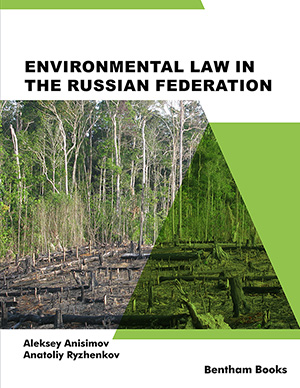Preface
Page: ii-iii (2)
Author: Aleksey Anisimov and Anatoliy Ryzhenkov
DOI: 10.2174/9789815049169122010002
Environmental Law as a Branch of Russian Law
Page: 1-36 (36)
Author: Aleksey Anisimov and Anatoliy Ryzhenkov
DOI: 10.2174/9789815049169122010003
PDF Price: $15
Abstract
This chapter begins with considering the basic concepts of the interaction
between nature and society that underlie the legal regulation of conservation of nature.
The authors review the concepts of sustainable development, circular economy, climate
change, and environmental law and draw attention to the methods (ways) of legal
regulation of environmental relations. Generally speaking, a method of legal regulation
is understood as a set of ways (techniques and means) enshrined in legal rules to impact
peoples behavior and their social relations governed by law. There are two methods of
legal regulation that function in environmental law: imperative and dispositive. The
imperative method in environmental law means the establishment of prescriptions,
permissions, prohibitions for the subjects of environmental legal relations and
manifests itself in the possibility of applying state coercion to the execution of legal
prescriptions by legal entities, citizens, including foreign ones, as well as by officials.
The dispositive method is based on the equality of the parties to legal relations and
their possibility to choose the particular behavior patterns independently. The citizens
right to establish public and other environmental associations is a typical example here.
The main stages of development of Russian environmental legislation are analyzed and
six levels of the sources of environmental law are distinguished subsequently in the
textbook. The principles of environmental law are also considered; these are the basic
ideas that underlie environmental law as a branch of law, determine its content and
areas for further development and are used in law enforcement practice in case there
are gaps in law. The authors distinguish generally accepted principles, interbranch,
branch principles and principles of institutions of law in the system of principles of
environmental law. A separate section in the textbook is dedicated to the system of
environmental law – its internal structure. It is followed by the section dedicated to
environmental legal relations –types of social relations regulated by rules of
environmental law of Russia. This chapter concludes with a section on ownership of
some natural resources.
Human and Civil Right to a Favorable Environment
Page: 37-61 (25)
Author: Aleksey Anisimov and Anatoliy Ryzhenkov
DOI: 10.2174/9789815049169122010004
PDF Price: $15
Abstract
This chapter deals with the main stages of the formation of environmental
rights in international law. The authors define the human right to a favorable
environment as the possibility for every person, people, and the whole humankind to
live with such a state of the Earths biosphere that ensures the maximum level of
physical and mental health, as well as means eliminating global threats to the biosphere
caused by human activity.
It is stated that further development of the system of environmental rights will
inevitably affect human rights and the environment, and the rights of environmental
refugees. The main authorities of Russian citizens and public associations in the field
of environmental protection are studied in terms of Russian legislation. These include
right to establish public associations and non-commercial organizations which carry
out activities in the area of environmental protection; the right to participate in
assemblies, rallies, pickets, processions and demonstrations, referendums and other
activities relating to environmental protection that are not contrary to legislation; the
right of citizens to require state authorities, local government bodies and other
organizations to provide timely, complete and reliable environmental information; the
right to propose organization of a public environmental expert review and participate in
it; the right to file complaints, applications and proposals concerning nature protection
issues and the negative impact of it on state authorities, local government bodies and
other organizations and to obtain timely and substantiated responses; the right of
citizens to file claims in court for compensation for harm caused to the environment, as
well as to their life, health and property, and the right to provide assistance to public
authorities in settlement of environmental protection issues. Further, the authors
consider environmental duties of citizens and their associations as well as state
guarantees of citizens rights (i.e., a set of Russian conditions for the exercise of
environmental rights and means of their protection in case of encroachment on them by
the state or third parties).
System of Environmental Management Bodies
Page: 62-96 (35)
Author: Aleksey Anisimov and Anatoliy Ryzhenkov
DOI: 10.2174/9789815049169122010005
PDF Price: $15
Abstract
In this chapter, it is pointed out that management in the area of
environmental protection lies in the domain of executive authorities of the Russian
Federation and its constituent entities as well as local government bodies. These bodies
aim at regulating the interaction between nature and society to ensure a favorable
environmental quality. Management activity in environmental protection is carried out
exclusively by state executive authorities and local government bodies. Legislative and
judicial authorities do not perform any management functions. In a similar manner,
public environmental associations and other legal entities are not involved in
management. Despite the common goals of environmental management, every level of
public environmental management (the Russian Federation, constituent entities of the
Russian Federation, local government bodies) has its own level of competence.
Management bodies in environmental protection can be classified according to several
criteria. The main criterion is the scope of their inherent authoritative powers.
According to this criterion, they are divided into general and special competence
bodies. Bodies of general competence are distinguished as a special type of public
authorities because decision-making in environmental protection is not their special
and only function; it is performed along with the fulfillment of other management
tasks. The President of the Russian Federation, the Government of the Russian
Federation, executive authorities of constituent entities of the Russian Federation, and
local government bodies are endowed with general competence.
Bodies of special competence are state authorities that are specially authorized by the
Government of the Russian Federation or the President of the Russian Federation to
perform the corresponding environmental functions (the Ministry of Natural Resources
and Environment, the Ministry of Internal Affairs, etc.). According to the nature of
their special competence, environmental management bodies are divided into two
types: interbranch and branch. Interbranch bodies perform a set of nature protection
tasks concerning all (or the majority) of natural objects or types of activities; branch
bodies protect the environment in certain life areas (transport, industry, power sector,
defense). It is pointed out that the Federal Law “On Environmental Protection” itself
does not distribute the powers among specific bodies of general or special competence.
The law lists the powers of federal, regional, and local nature protection significance,
and these powers are distributed inside each level of authority by other laws and
bylaws.
Attention is paid to environmental management functions, i.e., the main areas of
activities of state executive authorities and local government bodies to ensure a
favorable environmental quality and protect environmental human and civil rights
(standardization, licensing, expert review, EIA). The state economic regulation of environmental protection is not less important, and it includes the establishment of the
system of payments for environmental pollution, tax benefits, and other incentive
payments, including measures for the support of environmental entrepreneurship.
Legal Liability for Environmental Offenses
Page: 97-122 (26)
Author: Aleksey Anisimov and Anatoliy Ryzhenkov
DOI: 10.2174/9789815049169122010006
PDF Price: $15
Abstract
The authors suppose that legal liability for environmental offenses is
understood as a legal relationship between the state represented by specially authorized
authorities and the party that has committed an environmental offense (an individual,
an official or a legal entity) and is obliged to undergo state coercion measures in the
forms of particular forfeitures (of a person, property or organizational nature) for the
violation of rules of environmental legislation.
An environmental offense is a ground and the time of the commencement of legal
relations of legal liability; it is a guilty wrongful act entailing legal liability and
prohibited by environmental legal rules of the Russian Federation and constituent
entities of the Russian Federation; it infringes on the constitutional right of everyone to
a favorable environment and also causes harm to the natural environment (its objects
and components) or poses a real threat of this harm. An environmental offense (like
any other offense) includes four elements: the object, the objective aspect, the subject
and the subjective aspect. For the classification of an offense as environmental, the
object of the encroachment at the time of its commitment must be in the system of
ecological relationships with the environment. Liability for environmental offenses
performs a range of functions: stimulating (compliance with rules of environmental
legislation),preventive (making it possible to prevent new offenses), compensatory
(aimed at compensating for harm to the environment, the life, health and property of
people) and punitive (punishment of offenders). The authors raise a question about the
number of types of legal liability for environmental offenses.
The Federal Law “On Environmental Protection” itself mentions four types of liability
in Article 75: property, disciplinary, administrative, and criminal liability. Having
analyzed the scientific doctrine and practice, the authors state that environmental
offenses entail civil legal, administrative and criminal liability. Criminal and civil legal
liability are regulated only by federal acts. Suppose a person is brought to
administrative or criminal liability; in that case, he or she may also have to compensate
for the harm caused to the environment. However, it is impossible to bring anyone to
both administrative and criminal liability. Particular attention is paid to the issues of
compensation for environmental harm, which is taken as negative changes in the
quality of the environment that are caused by economic or other human activities
involving the destruction of ecological relationships, pollution, and destruction of
certain natural components and can result in harm to the life, health or property of
citizens (property of legal entities)
Legal Regulation of Environmental Protection in Certain Fields of Human Activity
Page: 123-167 (45)
Author: Aleksey Anisimov and Anatoliy Ryzhenkov
DOI: 10.2174/9789815049169122010007
PDF Price: $15
Abstract
The authors prove that with the purpose to implement the tasks of ensuring
the appropriate quality of the environment in Russia, environmental legislation
provides for a system of measures, which, along with giving a special legal status to
certain specially protected areas or establishing rules and regulations for the protection
and rational use of natural objects, also includes special environmental requirements
mandatory for observance and execution by all legal entities, individual entrepreneurs
and citizens engaged in various types of economic and other activities that have a
negative impact on the environment. The list of these types of activities is not
exhaustive and includes special rules and requirements for real estate construction,
operation of industrial, power and agricultural facilities, transport, etc. The
requirements are comprehensive and thus different from the duties imposed on users of
natural resources and third parties using certain natural resources (forests, water, etc.).
In particular, rules dedicated to the protection of forests from fires contain sufficiently
unique prescriptions that can be used only to protect forests. In a similar manner, the
measures for fauna protection through the maintenance of the Red Data Book are
clearly localized by this natural object. The comprehensive nature of the requirements
for certain types of activities consists in the fact that they are aimed at regulating the
activities threatening several natural objects rather than one. Requirements for
environmentally safe operation of power facilities are a typical example in this case.
Requirements for construction and operation of nuclear power stations are intended to
exclude any repetition of the tragedy of the Chernobyl Nuclear Power Plant, when the
radiation had a negative impact on not one component of the natural environment
(land, forests, water, fauna, air) but all at once, and the environment contaminated with
radiation caused harm to the life and health of hundreds of thousands of people. Harm
to nature and the health of citizens from tests of nuclear weapons or from more
peaceful activities, for example, the use of pesticides in agriculture is equally complex
with regard to its consequences. In the latter case, violation of environmental
requirements in the field of chemicalization of agriculture results in harm to land,
surface and ground water bodies.
Legal Regulation of Protection of Natural Objects
Page: 168-195 (28)
Author: Aleksey Anisimov and Anatoliy Ryzhenkov
DOI: 10.2174/9789815049169122010008
PDF Price: $15
Abstract
All types of natural objects are closely interlinked with each other.
Deterioration of the quality of one of them inevitably leads to particular consequences
for the condition of the other elements of the ecological system. This is why legislation
stipulates a range of measures aimed at protecting both the environment in general and
its constituent components. Land protection focuses on the preservation of soil fertility.
From the analysis of the Forest Code of the Russian Federation it follows that there are
nature protection rules of a general nature covering all types of forests and special rules
specifying these general provisions for certain categories of forests. In particular, the
general environmental rules consist in the fact that all forests are subject to protection
from fires, pollution (including contamination by radioactive substances) and other
negative impact as well as protection from harmful organisms. The legal regime of
water bodies varies depending on whether they are located on the surface of the earth
or they are ground water bodies. The Government of the Russian Federation approved
special rules for protection of both surface and ground water bodies. The task of water
protection is solved by imposing duties on the subjects of water relations – citizens and
legal entities as well as public authorities. For the purpose of water protection,
environmental and water laws establish a range of general and special requirements.
The protection of fauna habitat is one of the areas of fauna protection activities.
Legislation establishes two regimes of the protection of animals. The general regime of
the protection is established by the Federal Law “On Fauna” (based on the criterion of
the possibility of being an object of hunting and fishing, two categories of animals are
distinguished); the special regime is established in relation to animals attributed to
specially protected ones, including those listed in the Red Data Book of Russia.
Researchers point out two main problems in the area of rational use and protection of
subsoil. They are the inefficient use of subsoil resources with the increasing complexity
of field exploitation and the growing impact of mining on the environment. Finally, the
consistent system of legal rules regulating the protection of air from anthropogenic
impact is considered at the end of this Chapter
Concept and Types of Areas with a Special Environmental Legal Regime
Page: 196-221 (26)
Author: Aleksey Anisimov and Anatoliy Ryzhenkov
DOI: 10.2174/9789815049169122010009
PDF Price: $15
Abstract
The Russian Federation now stipulates the possibility of establishing two
special environmental legal regimes in the country, including specially protected
natural areas (SPNAs) and ecological disaster zones. The essence of both
environmental legal regimes consists of establishing a special procedure for the use and
protection of a clearly localized territory different from the regime of using land plots
and other natural objects of the country. This manifests itself in establishing features of
the management of this territory, the regime of restrictions of civil and corporate rights,
as well as additional funding of a range of special nature protection activities. The
purpose of the establishment of special restrictions and prohibitions for economic and
other use of these territories is to create additional guarantees of the achievement of the
main objective of environmental legislation – to ensure a favorable environmental
quality.
This means that the establishment of the special environmental legal regime is
necessary if the general environmental requirements (licensing, standardization, etc.)
do not make it possible to preserve and restore specific natural objects and systems in
the appropriate state. The list of the relevant prohibitions and restrictions is contained
in federal and regional environmental legislation as well as in land, water, forest
legislation, legislation on natural and cultural heritage, etc. Particular additional
measures in the area under consideration can also be adopted at the municipal level
with the corresponding legal acts of local government bodies. The legal status of both
varieties of areas with a special environmental legal regime (SPNAs and ecological
disaster zones) has several similar and different features. The purposes of giving a
particular territory a special environmental legal regime are also the same – to ensure
everyone's right to a favorable environment. Significant differences between these
territories consist in the objective related to them. SPNAs are created to conserve
certain ecological systems for present and future generations and to study the unique
natural areas; ecological disaster zones are created to restore disturbed ecosystems. In
this regard, the access of citizens to SPNAs is not prohibited (it is even encouraged),
while they have to obtain a special permit to enter an ecological disaster zone.
Consequently, the special regime is established to ensure the protection of two
territories that are opposite to their ecological state.
International Cooperation in the Field of Environmental Protection
Page: 222-243 (22)
Author: Aleksey Anisimov and Anatoliy Ryzhenkov
DOI: 10.2174/9789815049169122010010
PDF Price: $15
Abstract
In this chapter, it is stated that the international environmental law is a set of
international legal principles and rules governing international relations regarding the
protection of the environment from negative impact. These rules and regulations ensure
the rational use of environemnt and its components and provide favorable conditions
for the life and health of the present and future generations of people. The development
in international environmental cooperation was gradual, like the development of
national (Russian) environmental law. Some references to international cooperation in
this chapter in environmental protection can be found even in the era of the ancient
world. However, the full-fledged international cooperation in environmental protection
began only in the second half of the 19th century. This can be explained by the fact that
the human impact on nature was small before the Industrial Revolution. The negative
impact of the neighboring countries on nature arose with the massive construction of
plants that release emissions into the air and water bodies. This resulted in the need for
governments of different countries to agree on various parameters about the safety of
the environment. The development of international cooperation in environmental
protection is divided into several stages. It is pointed out that international
environmental law is a young branch of law closely interacting with other branches of
international law, including international maritime, air, and space law. These branches
of law regulate relations regarding the exploitation of the relevant natural resources and
are based on the exercise of the rights of sovereign states to use natural resources.
According to the authors, international environmental law has an independent subject
of legal regulation – international environmental relations, which can be conveniently
divided into three groups:
a) Relations for the prevention and limitation of the harmful impact on the
environment, which can be resolved only by efforts of the entire world community
(pollution of the World Ocean, the air basin, pollution of the environment during
military conflicts, etc.);
b) Ensuring the rational use of international natural resources (for example, resources
of the sea bed);
c) Protection of unique natural objects through their conservation from human
economic impact (for example, natural heritage sites, wetlands, rare animals and plants,
etc.).
The subjects of international environmental law include states, international
organizations, and international non-governmental organizations. However, states are
the main subject of international law.
Legal Regulation of Environmental Protection in Foreign Countries
Page: 244-280 (37)
Author: Aleksey Anisimov and Anatoliy Ryzhenkov
DOI: 10.2174/9789815049169122010011
PDF Price: $15
Abstract
In the era of globalization, international cooperation becomes more
important since no country in the world can solve the problem of global climate change
or pollution of the World Ocean on its own. However, the interpenetration of the most
successful legal rules and institutions of other countries into national legal systems is a
no less significant trend. The study of this comparative aspect makes it possible to
better understand the advantages and disadvantages of Russian environmental
legislation, formulate constructive suggestions for the Russian legislator, and identify
possible ways of bilateral cooperation in environmental issues that are understood in
the national legislation of two or more countries.
Russian environmental legislation is more closely linked to the CIS countries both for
the geographical reason (as neighbors) and because these countries were part of the
USSR for many years, and the approaches to the legal regulation of environmental (and
many other) social relations that were established during that period of our joint history
are still used today. The environmental laws of the Russian Federation, the Republic of
Kazakhstan, and the Republic of Belarus can be compared as an example. The criterion
for comparison is the content of the main environmental legal institutions included in
these laws. The relevant environmental legal institutions in Russia and these countries
can coincide completely, partially, or don’t not coincide at all. The main focus in this
chapter is not so much on comparing the laws of the Republics of Kazakhstan and
Belarus with each other but comparing them with the basic institutions of Russian
environmental law. The fundamental difference between environmental law of the
European Union and the Russian Federation is not only the supranational nature of EU
directives but also the fact that the EU almost does not regulate natural resource
management issues e.g., in terms of the procedure for the provision of natural resources
based on the right of ownership or other rights. This is the scope of national legislation
of the member countries.
Both in Russia and the environmental law of the EU, we can observe a trend of
ecologization of related legislation: it means environmental rules are introduced into
the regulatory acts governing related areas of social relations (transport, power
industry, fight against unemployment, etc.). Moreover, in this chapter, the authors point
out several characteristics of not only the environmental law of the United States but of
Russia, China, the European Union, or many other countries and consider the current
distinctive features of the nature protection policy of China.
Introduction
Environmental Law in the Russian Federation presents a comprehensive textbook on the current state of environmental legislation of the Russian Federation. The textbook is divided into three sections that are ordered for an increasing level of specialization in the subject. - The first section (General Part) gives a definition of environmental law, formulates its principles and considers the sources of environmental law and legal relations. Readers will learn about the issues related to the ownership of natural resources, the legal framework and specifics of environmental protection and management, and associated human and civil rights. The distinguishing features of economic regulation in the area of environmental protection as well as issues of responsibility for environmental offenses are also covered. - The second section (Special Part) sets forth the main environmental requirements for certain types of economic and other human activities and the specifics of environmental protection in areas with a special environmental legal regime (specially protected areas and ecological disaster zones). Chapters in this section consider the main areas of protection of certain natural objects (water, forests, land, etc.). - The third section (Specialized Part) clarifies the main areas of international cooperation in the field of environmental protection and considers the main characteristics of the environmental protection experience of other countries. The textbook is an essential reference for law and business students in Russian schools. It is also of interest to entrepreneurs planning ventures in Russia and researchers involved in comparative legal analysis.













